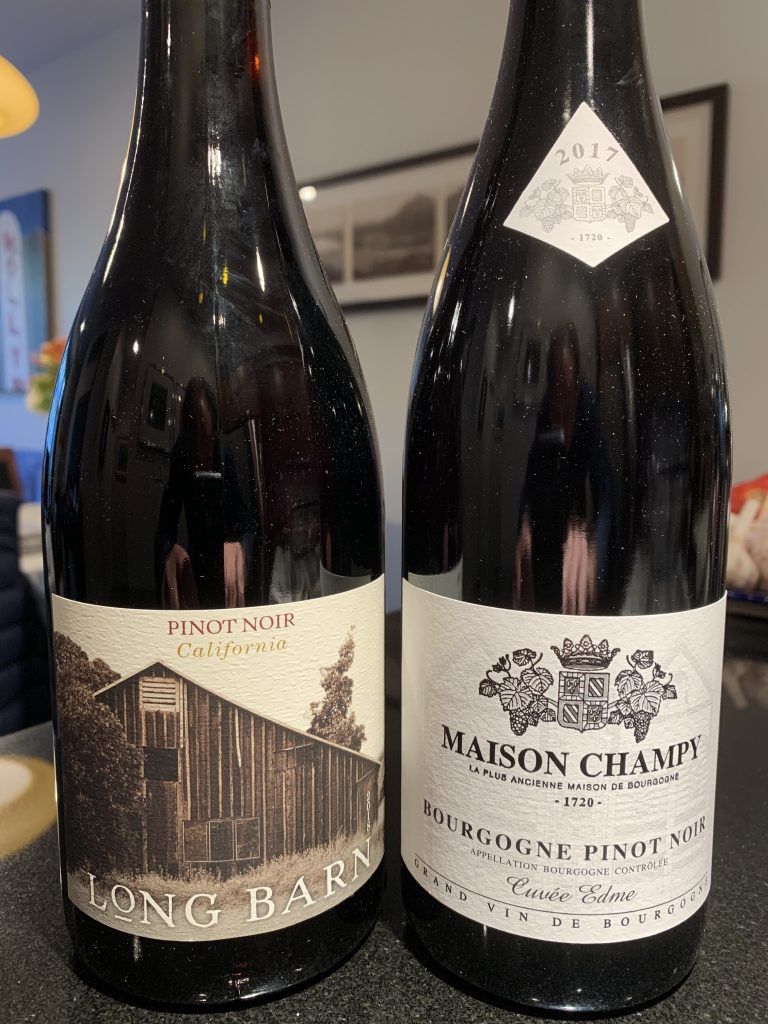
Two Pinot Noirs, one from California and the other from Burgundy
The second session of my ongoing Wine Fundamentals online wine tasting course took place on Tuesday evening. After tasting two Chenin Blancs side by side last week, this week we turned our attention to the ‘heartbreak’ grape, Pinot Noir. Oh boy…it earns its nickname!
Pinot Noir is of course the grape which makes Burgundy’s red wines, and great red Burgundy is the holy grail for many wine aficionados. It is also the wine that many winemakers around the world aspire to, and more and more impressive pinot noir examples are emerging in diverse wine regions: think Oregon’s Willamette Valley; California’s Sonoma Coast, Carneros and Sta. Rita Hills; Australia’s Yarra Valley and Tasmania; New Zealand’s Central Otago; Chile’s Casablanca and San Antonio valleys; South Africa’s Hemel-en-Aarde Valley; even BC’s Okanagan Valley. Great pinot noir is being made in all these places and more.
For this week’s lineup, I selected a pinot noir from California and another from Burgundy (of course!). Good pinot is often very pricey (especially from Burgundy), so budget was a big consideration in my selection, meaning that I had to go with regional level blends from both areas rather than more specific appellation (AVA or AOP ) wines. This was reflected in the quality level of these two wines. While both wines were pleasant enough and quite different stylistically, neither showed very much of the subtle elegance, complexity and ethereal qualities that great pinot often promises but frankly seldom delivers. You have to pay a lot more for that experience, it seems.
The Long Barn California Pinot Noir 2018 was first up. This is a regional blend made by Fiore di Sole in their Napa Valley facility, which produces large volume brands across all categories for several growers.
The wine was typically (for pinot noir) lighter in colour, with a lovely, fresh bouquet dominated by mostly red fruits and a hint of sweet vanilla, from some oak presumably. This continued through on the palate, with sweet red cherry, strawberry, redcurrant and plum to the fore, on a soft, smooth tannic structure. A fresh, fruit-forward, easy to drink wine, made in a style that is pleasing to many consumers.
The second wine was the Maison Champy Bourgogne Pinot Noir Cuvée Edme 2017. Again, this is a regional appellation wine made from grapes grown across Burgundy, perhaps with some fruit off less propitious vineyards in the fabled Cote d’Or but likely also from other less pricey areas such as the Cote Chalonnaise. Maison Champy claims to be the oldest operating ‘maison’ in Burgundy, and was recently sold to French conglomerate Advini. They make the full range of wines from basic Appellation Bourgogne all the way up to the most prestigious Grand Crus.
Similar in colour to the previous wine, perhaps a touch lighter if possible. The bouquet was more savoury however, with earthy, forest floor, vegetal, even gamey notes along with mostly black fruits such as blackberry and raspberry, and sour cherry. The red and black fruits were rather dominated by the pronounced acidity. The tannins were smooth and supple however, and it had a medium finish. 2017 was a solid, rather than outstanding, vintage year in Burgundy, with large volumes of mostly healthy grapes. Some producers picked their red grapes a little early to avoid impending rain, and it’s possible this wine was made from such grapes, as it had a slightly green stalkiness. Definitely a wine to enjoy with food, as was proven the following night chez nous.
So, while neither wine showed the greatest heights to which pinot noir can climb when grown in the optimal terroir, nor were they sub-par, just perhaps a bit underwhelming, especially when you consider what you have to pay for red Burgundy (this Bourgogne retails at around $40 plus taxes).
You don’t know what you’re going to get when you open a bottle of pinot noir: sometimes it can be utterly sublime, other times rather ordinary. So many factors are at play: the vineyard location and the grower’s viticultural decisions, the vintage weather conditions, choices made during the winemaking, the quantity and quality of oak used, the age of the wine, and so on. But one thing’s for sure: A great Pinot Noir is incomparable and wine lovers will continue seeking it out, regardless of any disappointments along the way. This tasting session was but an introduction to its many guises.